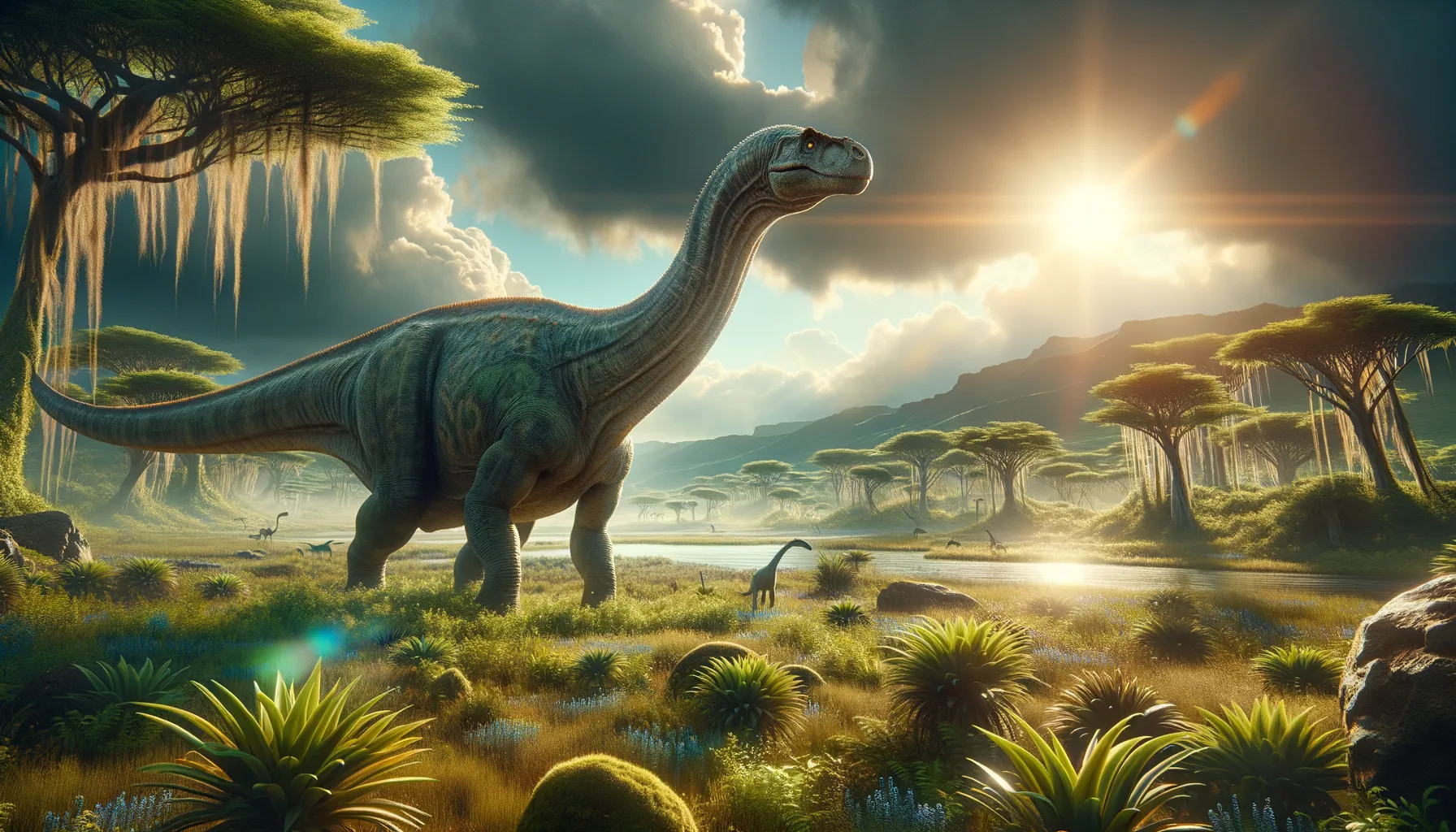
Lapparentosaurus
Jurassic giant with a leafy appetite.
Period
Jurassic
Length
Could reach lengths of up to 49 feet.
Height
Approximately 10 feet tall at the shoulder.
Weight
Weighed around 15 to 20 tons.
Lapparentosaurus was a long-necked, massive dinosaur that roamed the Earth during the Jurassic period. Known for its impressive size, it lived primarily in what is now Madagascar. Its fossil remains have significantly contributed to our understanding of dinosaur evolution and ecology. Predominantly a plant-eater, this giant sauropod adapted to a life of grazing on abundant vegetation and maneuvering through the lush prehistoric landscapes.
Diet
Lapparentosaurus was herbivorous, feeding on a variety of plants. Its diet likely consisted of conifers, cycads, and ferns, available in its Jurassic habitat.
Hunting
Being herbivorous, Lapparentosaurus did not hunt. It spent most of its time grazing on vegetation, using its long neck to reach higher branches.
Environmental challenges
Lapparentosaurus faced a range of environmental challenges, including climate fluctuations and the availability of sufficient food sources. It lived in a world dominated by vast forests and diverse ecosystems. During periods of scarcity, it might have had to travel long distances to find food. Natural predators, such as theropods, would have also posed a significant challenge.
Speed
Slow mover, typical of large herbivores.
Lifespan
Estimated to be several decades long.
First discovery
Discovered in 1946 by José Bonaparte in Madagascar.
Fun Facts
- Lapparentosaurus lived during the Middle Jurassic period, around 166 million years ago.
- It was named in honor of French paleontologist Albert-Félix de Lapparent.
- Lapparentosaurus was a sauropod, which means it was a long-necked, herbivorous dinosaur.
- Fossils of Lapparentosaurus have been found in the Betsiboka region of Madagascar.
- This dinosaur is known primarily from juvenile specimens, so adult size and features are somewhat of a mystery.
- Lapparentosaurus was part of the same group as more famous giants like Brachiosaurus and Diplodocus.
- Despite its giant size, Lapparentosaurus was a gentle plant-eater, roaming prehistoric landscapes in search of food.
Growth and Development
Lapparentosaurus experienced rapid growth during its early years, allowing it to reach a formidable size for protection against predators. Its bone structure suggests that it had a high metabolic rate compared to modern reptiles. Its life cycle from hatchling to adult involved significant changes in size and possibly behavior. Achieving full size would have marked a transition to a more sedentary, foraging lifestyle.
Habitat
Lapparentosaurus inhabited forested regions with abundant plant life. It lived in what is now Madagascar, which had a warm climate during the Jurassic. Its habitat allowed access to diverse vegetation, crucial for its survival as a herbivore. The environment provided both opportunities and challenges, such as competing with other herbivores for resources.
Interaction with other species
Lapparentosaurus coexisted with other herbivorous and carnivorous dinosaurs. It likely had to compete for food with other plant-eaters. Its size was a deterrent to most predators, though smaller theropods may have targeted the young or weak. Mutual existence within complex ecosystems resulted in various forms of interaction, from competition to predator-prey relationships.
Natural lifespan
Its natural lifespan could reach up to 70 years.
Reproduction
Lapparentosaurus likely reproduced by laying eggs in nests built from vegetation. Clutch sizes may have varied, and parental care might have been limited. The process of hatching and juvenile growth is a subject of ongoing research. Young Lapparentosaurus would have been vulnerable to predators until reaching a size sufficient for deterrence.
Social behaviour
This dinosaur might have lived in herds or loosely associated groups for improved safety. Social behavior could have included communication through vocalizations or body language. Group living provided advantages like shared vigilance against predators. Herd dynamics may have influenced migration patterns and feeding behavior.
Fossil locations
Most Lapparentosaurus fossils have been found in the Mahajanga Basin of Madagascar. This area provides insight into the diverse ecosystem of the Jurassic period. The discoveries in Madagascar have been essential in reconstructing its biology and ecology. Fossilized bones have shaped the understanding of its anatomical and physiological traits.
